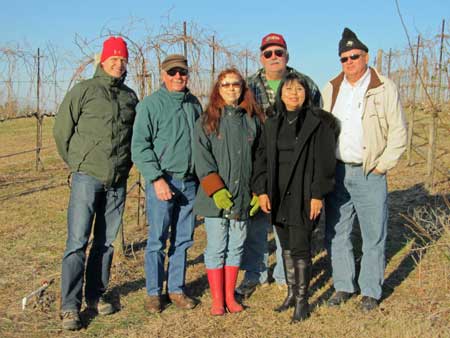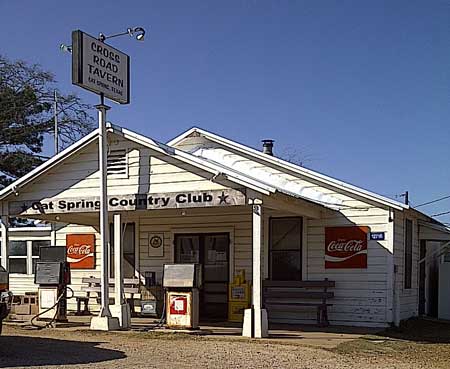Texas Gulf Coast Vineyard Tour: What Grapes are Those, Ed? They’re our Favorites!
This past Thursday, the air was clear and dry and the high sun gave its brightness and warmth to the winter afternoon as I made my way west. My destination was Austin County; Cat Spring, Texas to be precise to meet-up with the “growing number” of this region’s wine grape growers.
After I arrived at the Watson Vineyard and stowed my overnight sack in Jerry Watson’s bunkhouse, I came downstairs to see Texas Agrilife Extension Viticulturalist, Fritz Westover, pondering over one of his next day’s presentations that he would give at the 19th Annual Gulf Coast Grape Growers Field Day. We were awaiting the arrival of Andy Scott from Rio Farms (Monte Alto, TX) and new valley grape grower Norma Linda Sanchez up from the Edinburg area in the Rio Grande Valley. Both would accompany us on a tour of Louise and Ed Rice’s vineyard in nearby Industry, Texas.
It appears that times are a-changin’ for Rio Grande agriculture and wine grapes are part of its future. Rio Farms and Andy Scott have been working with grapes since 1992 in the region that Texans simply call “The Valley”. While it all started out as research to help grow table grapes down there, things have now turned to growing grapes for Texas wine. While the oenophiles that were weaned on rich Bordeaux and fine Burgundy may find south Texas viticulture inconceivable, they will be quite surprised. Andy has become both technical adviser and ambassador for the growing of Black Spanish and Blanc du Bois grapes near the banks of the Rio Grande, long known for vegetables and citrus.
As I waited for our south Texas guests, I perused my emails and found an electrifying message from my publisher. She said that two reviews of my book manuscript on my Texas wine experiences came back. They were favorably impressed. Just after my round of high fives to all in the Watson house, Andy and Linda arrived.

Left to right: Fritz Westover, Jerry Watson, Louise Rice, Ed Rice,
Norma Linda Sanchez, Andy Scott
Andy and Linda were surprisingly fresh after their six hour drive up from the valley and ready to see what they made the trip for – the mature vineyards composed of Blanc Du Bois and Black Spanish. Andy, carpooling with me, seemed to be fully charged; excited about his upcoming vineyard experience. As we drove over rolling hills, Andy talked in his rapid-fire manner about the research at Rio Farms while I mostly listened. It was a clangor of facts, figures and curious experiences around what I imagined at one time were odd-looking sweet red grapefruits, soybeans adapted to tropical locales, and now wine grapes growing on the banks of the Rio Grande River.
Previously, Fritz and Andy spent time talking about one of the biggest unknowns when it came growing grapes near the Rio Grande: the root stock on which the grapevines would need to be grafted. In their trials, they settled on a native grape root stock called Dog Ridge. It has particular notoriety since back in the late 1800s, T.V. Munson found this grape variety to be tolerant to the high pH limestone festooned soils in its native central Texas region. He also realized that this made it compatible with the soils in France. Munson used Dog Ridge as one of several varieties of root stock that he sent to France which successfully combatted the disease Phylloxera that nearly wiped out the French and European vineyards back then. Now, Dog Ridge had a new yet just as important role in limey soils of south Texas.
Ed and Louise met us on their property just outside Industry proper. We all walked over to their compact vineyard. We ambled through the vineyard that crown a gentle hill. It was apparent that it was a wonderful vineyard site overlooking the adjoining lower regions in all direction. If I’ve learned one thing in all of my Texas vineyard exploits, it’s one thing. The vineyard needs to be where most people put their house: at the highest location so that cold air can drain downhill to minimize frost problems in the vineyard. Remember what you learned in high school science class – warm air rises. Therefore, heavier cold air flows downhill just like water.
Fritz discussed the progression of the partially completed pruning that was a work-in-progress in the Rice’s vineyard. He noted bud locations, shoot positions and an innovative trellising arrangement that he called simply “the Western Sprawl” [BTW – That’s not a name of a Country & Western dance] that he was investigating in the Rice’s gulf coast vineyard. This scheme positioned some canes vertically, but also left some canes hanging loose on the western side of the wine. It’s innovation was that this system positions both canes and grapes low and high on the vine, allows for a more open canopy and sunlight penetration, and comfortably increases vineyard yields by perhaps 30 or more percent. Andy and Linda both asked questions while Andy took pictures with his particular dexterity: both asking questions, engaged in technical conversation while also photographically covering seemingly every possible camera angle.
As Fritz, Linda and Andy lead the way farther up the rise into the vineyard, Jerry, Ed and I followed behind. We were slowly slogging along when I pointed to a row of vines next to us and asked Ed, “What grapes are those, Ed?”
He responded, “They’re our favorites.”
Then, I said, “OK, I understand that Ed. I know that you’ve developed a fondness for them, but tell me what variety of grape they are, anyway?”
He said again, but this time a bit more forcefully and seriously, “They’re our favorites…favorites, you know.”
Our banter had taken on the timing of an Abbott and Costello routine. Ed and I started to laugh. Ed realized that I was joking with him. I knew that when he said “their favorites” that he meant that these grapes where in fact Favorite, a hybrid grape variety that was a cross between Black Spanish (Lenoir) and Herbemont.
The playful moment lingered in the cold still air as Ed called for his dog, and our group stopped for a vineyard photo-op. I juggled all four cameras, mine along with those from Andy, Linda and Jerry. Afterwards, we headed back to the warmth of our vehicles in the late yellow glow of the slanting sun.
Our group caravanned back to Jerry’s place and took a last-light gander at his historic vineyard that’s been worked by Jerry’s careful hands for more than a quarter century in this most unexpected of all locations: on the Texas Gulf Coast. As the dull cold of evening started to penetrated our fingers, we joined other gulf coast growers and winemakers for dinner, discussions of vineyard pests of all sorts, and Texas wine quality, all plied with a “little” Texas gulf coast wine made from Blanc Du Bois and Black Spanish.




Be the first to comment